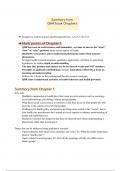Samenvatting
Exam Summary for EPH1023 (Qualitative Health Research) January Module
- Instelling
- Maastricht University (UM)
This is a summary of all the book chapters that year 1 European Public Health students have to read for the qualitative health research module that takes place in jaunary and lasts only 4 weeks. The exam will contain questions that are directly from the book therefore, this summary saves you the ti...
[Meer zien]













